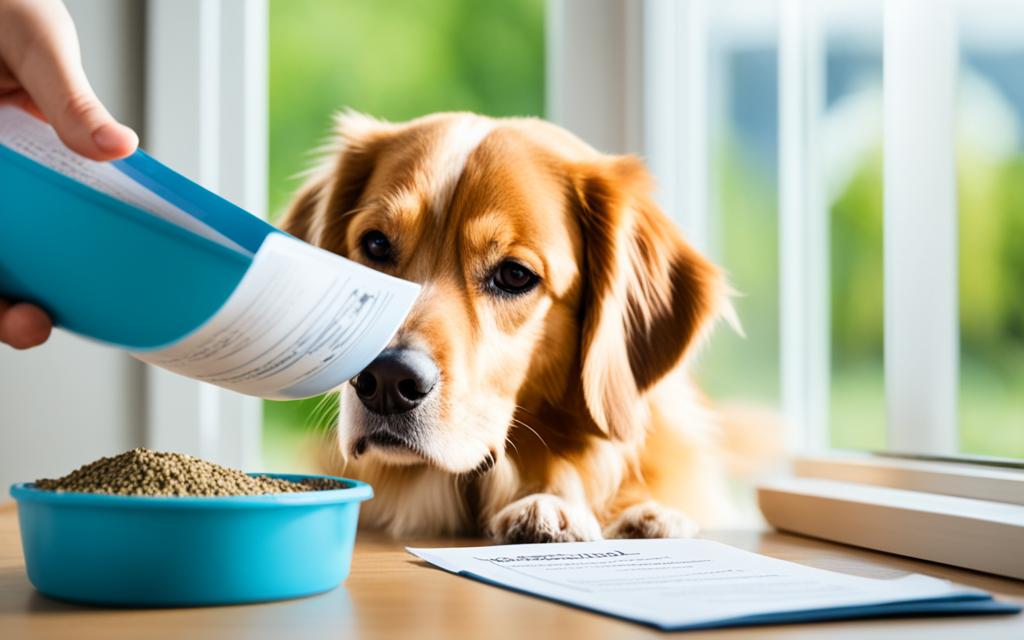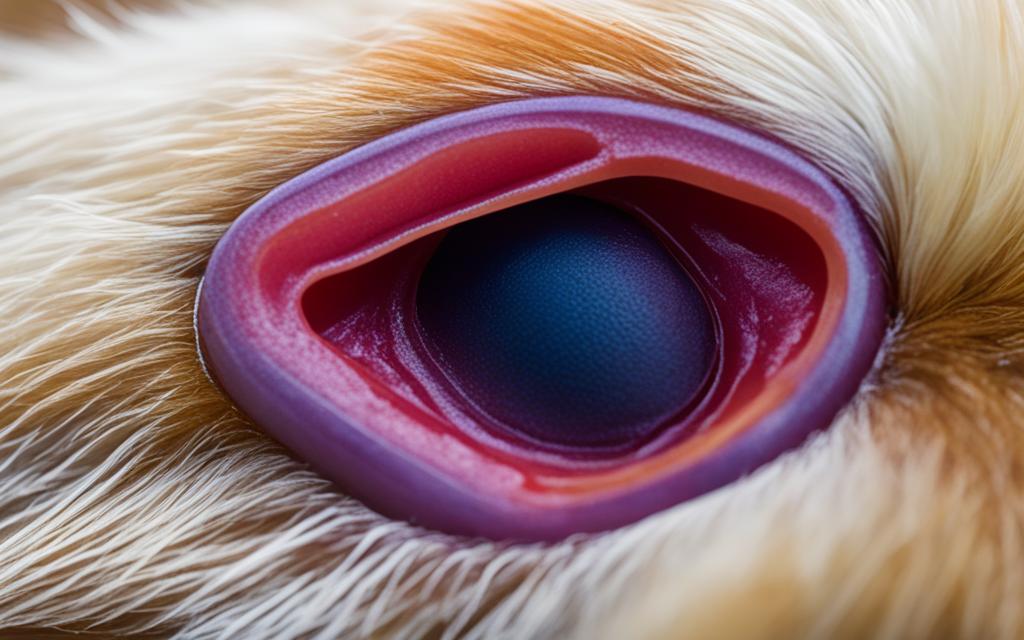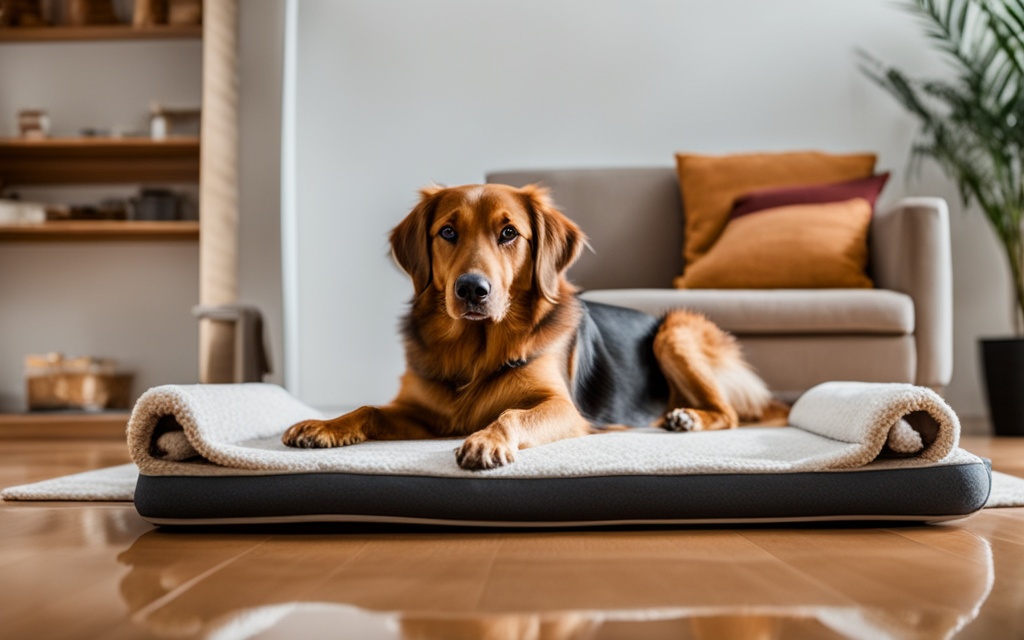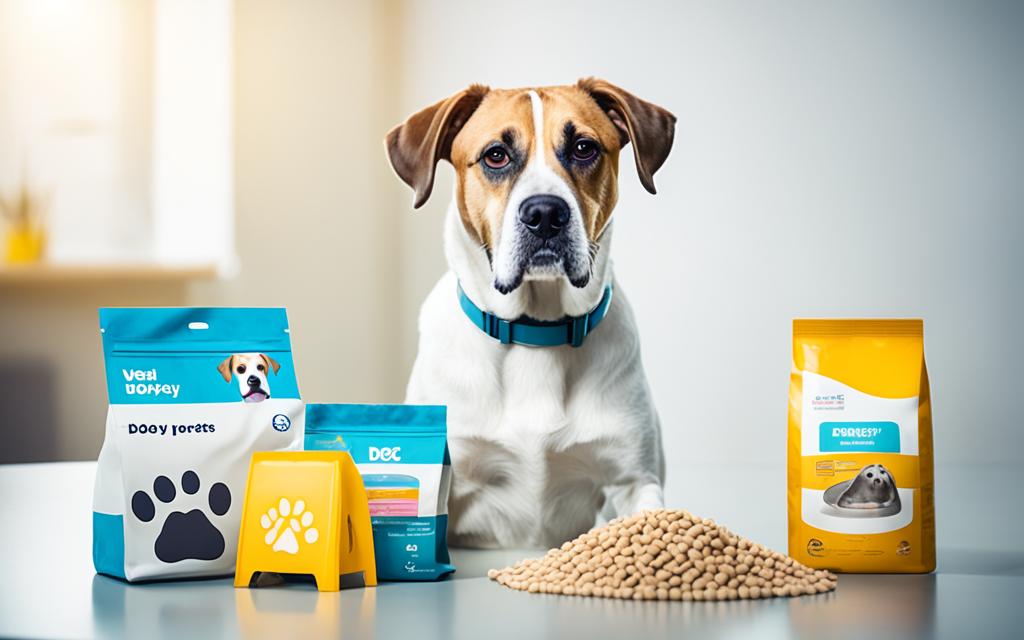Many dog owners struggle with dog allergies, making their pets uncomfortable and distressed. It’s important to know how to adjust your dog’s diet and living space to help. By choosing hypoallergenic dog food and changing their environment, you can ease their symptoms. This guide will share useful tips and strategies to improve your pet’s health and happiness.
Understanding Dog Allergies
Dog allergies can really affect a pet’s life. It’s important to know the different types of allergies. This helps pet owners spot allergic reactions in dogs better. Dogs can have food allergies, environmental allergies, or flea allergies, each causing different immune system responses.
Common Types of Allergies in Dogs
Knowing the types of dog allergies makes it easier to manage them. Here are the main categories:
- Food Allergies: Often caused by ingredients like beef, chicken, or grains.
- Environmental Allergies: Triggered by pollen, mold, dust mites, or other environmental substances.
- Flea Allergies: An allergic reaction to flea saliva, causing intense itching.
Signs and Symptoms of Allergies
Spotting the symptoms of dog allergies is key to quick action. Pet owners should watch for common signs, such as:
| Symptom | Description |
|---|---|
| Itching | Excessive scratching, especially around the ears, paws, and belly. |
| Skin Irritations | Red, inflamed patches of skin or hives. |
| Ear Infections | Frequent shaking of the head or pawing at the ears. |
| Gastrointestinal Issues | Vomiting or diarrhea, often linked to food allergies. |
Spotting these symptoms early can help manage them better. This way, dogs can live more comfortably.
Importance of Dietary Management
Managing your dog’s diet is key to keeping them healthy and happy. Many dogs react badly to certain foods. Knowing how diet affects allergies helps owners make better choices to ease symptoms and boost health. An anti-inflammatory diet can greatly help reduce allergic reactions.
How Diet Affects Allergies
The connection between diet and allergies in dogs is crucial. Some foods can cause allergic reactions, leading to itching, inflammation, and stomach problems. A well-managed diet can lessen these issues and make your dog’s life better. Choosing foods with ingredients known for being hypoallergenic can lead to better health and less need for medication.
Choosing High-Quality Dog Food
When picking dog food for allergies, choose products without common allergens. Ingredients like corn, soy, and artificial additives can cause allergic reactions. Brands like Blue Buffalo and Wellness CORE offer natural recipes that focus on your dog’s health. Look for foods with high-quality protein and made for sensitive stomachs to keep your dog happy and comfortable.
Managing Dog Allergies with Diet and Environment Changes
Making changes to your dog’s diet can help manage allergies. Elimination diets are a key way to find out what foods cause allergies. By taking out certain foods, you can see which ones make your dog react badly. This method needs careful planning and sticking to it for the best results.
Elimination Diets: What You Need to Know
Starting an elimination diet for your dog means taking out common allergens from their food. You might use special dog food or make your own diet with fewer ingredients. Watch your dog closely for any signs of improvement or worsening symptoms. Regular checks help you see if the diet is working.
After a while, you can start adding back in foods one at a time. This helps you figure out which food is causing the allergy.
Incorporating Hypoallergenic Ingredients
Using hypoallergenic ingredients can make your dog feel better. Choose proteins like duck or venison that are less likely to cause allergies. Also, pick brands that focus on simple diets to reduce allergy risks. These diets have fewer ingredients, making it easier to control allergies through diet.
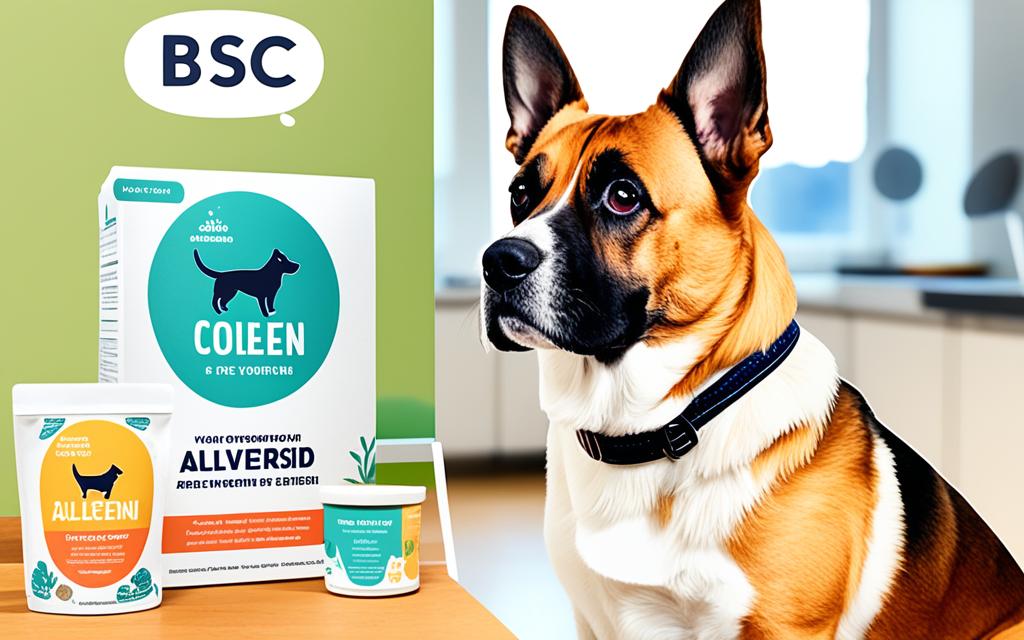
Environmental Adjustments to Minimize Allergies
Managing allergies in dogs means focusing on their environment. Small changes can make a big difference in their health and comfort. It’s important to keep their living space clean and reduce their exposure to allergens outdoors. Here are some easy tips to help you do this.
Creating a Clean Living Space
A clean living space can help reduce your dog’s allergy symptoms. Here are some steps to follow:
- Regularly vacuum using a HEPA filter vacuum to reduce dust and dander.
- Wash your dog’s bedding often with hypoallergenic detergent.
- Keep your home free of clutter where dust can gather.
- Remove stuffed toys that can trap allergens from your dog’s area.
These actions help manage dog allergies at home and make a healthier space for your pet.
Reducing Exposure to Allergens Outdoors
Being outside can expose your dog to allergens. Here’s how to reduce their exposure:
- Avoid walks during peak pollen times, like early morning or windy days.
- Wipe your dog’s paws with a damp cloth after being outside to remove allergens.
- Create a safe outdoor play area away from pollen-heavy plants.
- Use pet-safe allergy medications if your vet recommends them.
By adjusting both indoor and outdoor environments, you can improve your dog’s life. Proper management of their environment is key to their well-being.
Identifying Environmental Allergens
Finding the right approach for identifying allergens that can impact your dog involves understanding the various sources they can come from. It’s important to know about common outdoor and indoor allergens for dogs. This knowledge helps in managing your furry friend’s allergies and creating a healthier environment.
Common Outdoor Allergens
Outdoor allergens can significantly affect dogs during specific seasons. Here are some common outdoor allergens to watch for:
- Pollen from trees, grasses, and weeds
- Mold spores that thrive in damp outdoor areas
- Dust and dirt that can be stirred up during activities
Indoor Allergen Sources
Indoor environments can also harbor many allergens that impact dogs. Knowing these sources helps in minimizing exposure. Consider the following indoor allergens for dogs:
- Pet dander from other animals
- Dust mites that thrive in carpets and bedding
- Airborne particles from certain cleaning products
Using Air Purifiers and Humidifiers
Implementing air purifiers and humidifiers can greatly enhance indoor air quality. Air purifiers remove dust, pet dander, and other airborne pollutants. Humidifiers keep moisture levels balanced. Both can help in reducing allergens in your dog’s environment, creating a more comfortable space for them.
| Allergen Type | Common Sources | Mitigation Strategies |
|---|---|---|
| Outdoor Allergens | Pollen, Mold | Avoid walks during high pollen times; rinse off post-walk |
| Indoor Allergens | Pet Dander, Dust Mites | Regular cleaning, use of air purifiers |
Implementing an Allergy-Friendly Routine
Keeping a regular grooming routine is key to handling dog grooming allergies. An approach focused on allergies can lessen discomfort and keep your pet well. By taking the right steps during grooming, you can cut down on allergens like dander and loose fur at home.
Bathing and Grooming Tips
Choosing a hypoallergenic shampoo is crucial when bathing allergic dogs. These shampoos are gentle and help reduce irritation. Regular baths help remove allergens and keep the coat clean. Here are some tips for effective grooming:
- Always choose a shampoo specifically formulated for allergic dogs.
- Bathtub time should ideally be limited to once every 4-6 weeks unless more frequent washing is needed due to dirt or odor.
- Using warm water can provide a soothing experience for your dog.
- Thoroughly rinse to eliminate any remaining shampoo residue, as this can further irritate the skin.
How Often Should You Groom Your Dog?
The grooming frequency depends on your dog’s breed and coat type. For dogs with allergies, regular grooming reduces loose hair and allergens. Here’s a general guideline:
| Coat Type | Grooming Frequency |
|---|---|
| Short Coat | Every 4-6 weeks |
| Medium Coat | Every 3-4 weeks |
| Long Coat | Every 2-3 weeks |
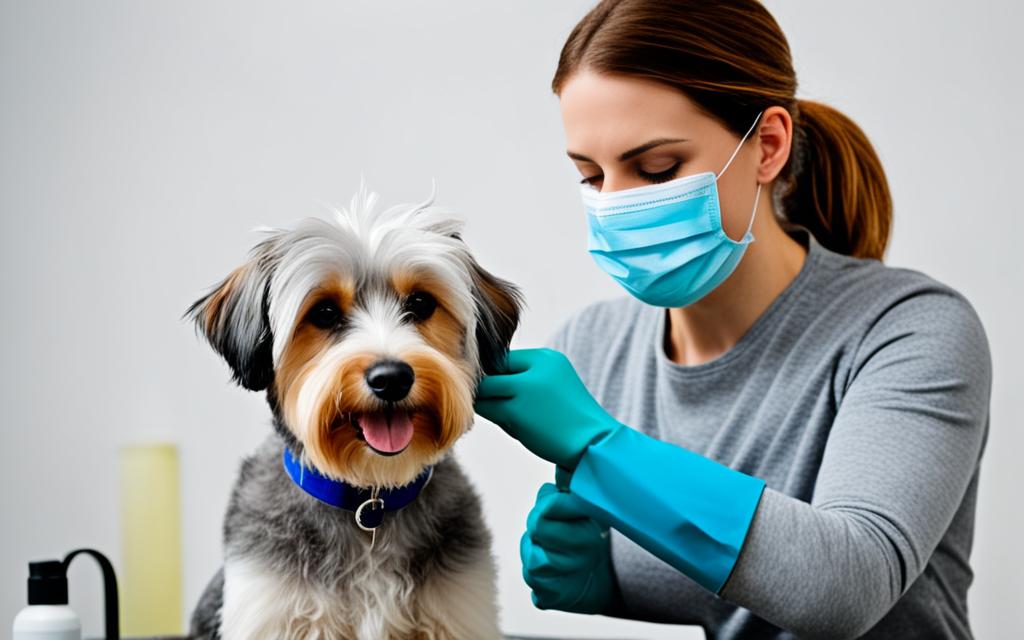
Consulting with a Veterinarian
Dealing with dog allergies can be tough. A vet who knows about dog allergies can give you the right advice and treatment. It’s important to know when to see a vet for allergies. If your dog’s symptoms don’t get better at home, it’s time to get professional help.
When to Seek Professional Help
If your dog keeps itching, has stomach problems, or skin issues, it might be serious. Other signs you should see a vet include:
- Worsening or acute symptoms after trying home remedies
- Signs of secondary infections, like redness or swelling
- Behavior changes, including excessive licking or biting
Types of Tests for Diagnosing Allergies
After seeing a vet, they might suggest allergy tests for your dog. These tests help find out what your dog is allergic to. Here are some common tests:
| Type of Test | Description |
|---|---|
| Skin Test | A test where small amounts of allergens are introduced to the skin to observe reactions. |
| Blood Test | Measures the presence of antibodies in the bloodstream to specific allergens. |
| Food Trials | Involves feeding a novel diet to assess if food allergies are present. |
These tests give important clues about what your dog is allergic to. They help create the best treatment plan.
Living with a Dog with Allergies
Managing allergies in dogs means taking care of them every day. This keeps them comfortable and safe from allergic reactions. Here are some easy tips to make life better for both you and your pet.
Tips for Everyday Care
Make a routine that includes cleaning and feeding your dog right. Here are some tips to follow:
- Choose hypoallergenic dog food free from common allergens.
- Maintain a clean living environment by regularly vacuuming and using air purifiers.
- Establish an outdoor routine that avoids areas with high pollen counts.
- Keep your dog away from known irritants, such as certain plants and chemicals.
Traveling with Allergic Dogs
Traveling with dogs that have allergies needs careful planning. It’s important to manage allergies while traveling to keep your pet healthy and happy.
- Pack travel-friendly hypoallergenic food to avoid unexpected allergic reactions.
- Map out routes to avoid hotspots for allergens, such as specific parks or fields.
- Bring along necessary medications in case of allergic reactions.
- Keep your dog on a leash in unfamiliar areas to prevent exposure to hidden allergens.
Alternative Treatments for Dog Allergies
Dealing with dog allergies goes beyond what vets usually suggest. Many pet owners look into holistic and natural remedies. This section talks about home remedies for dogs and the perks of allergy shots for dogs.
Home Remedies and Supplements
Pet owners often try home remedies to ease allergy symptoms. Some common methods include:
- Oatmeal Baths: Oatmeal soothes itchy skin and keeps it hydrated. It can be added to baths or used as a paste.
- Apple Cider Vinegar: It balances skin pH and prevents yeast infections. Always dilute it before applying.
- Fish Oil Supplements: Fish oil is full of omega-3 fatty acids. These reduce inflammation and boost skin health.
Using these remedies can help ease allergy symptoms. This makes your furry friend’s life better.
Potential Benefits of Allergy Shots
Allergy shots for dogs, also known as allergy immunotherapy, are another option. This method makes your dog less sensitive to allergens over time. It involves:
- Diagnosis: Finding out which allergens affect your dog through tests.
- Administration: Starting with a small dose of allergens and slowly increasing it.
- Commitment: Shots are needed regularly for a long time, often for years.
Allergy shots require a big commitment but can offer lasting relief from allergies. If you’re thinking about this, talk to your vet for advice.
Monitoring Your Dog’s Progress
Keeping an eye on your dog’s health is key to managing allergies well. A symptom diary for allergies is a great tool. It helps you track reactions to foods or environmental factors. This way, you can make better treatment and management choices.
Keeping a Symptom Diary
A symptom diary is like a log for your dog’s health over time. You should note down important details. These include:
- Dates of allergic reactions
- Foods consumed, including any changes in diet
- Environmental exposures, such as trips outside or time spent in different locations
- Symptoms observed, including itching, redness, or digestive issues
Adjusting Your Approach Based on Results
It’s important to regularly check your diary for patterns or triggers. This helps you make smart changes to your dog’s diet or environment. Being flexible is key. As things change, so should your approach to keep your dog happy and healthy.
Conclusion
Managing dog allergies requires both diet and environment changes. By knowing what allergens to avoid, pet owners can make their pets happier. Using high-quality food, keeping things clean, and creating a safe home are key steps.
It’s important to watch your dog’s health closely. Keeping an eye on symptoms and adjusting care as needed is crucial. Working with a vet to create a special plan helps pet owners care for their dogs better.
Staying committed to these steps helps dogs with allergies live better lives. Managing dog allergies takes effort, but seeing your pet happy and healthy is worth it.
